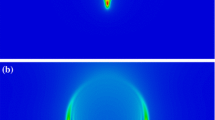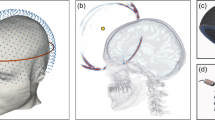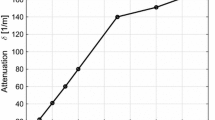Abstract
We present a class of model-free Data-Driven solvers that effectively enable the utilization of in situ and in vivo imaging data directly in full-scale calculations of the mechanical response of the human brain to sonic and ultrasonic stimulation, entirely bypassing the need for analytical modeling or regression of the data. The well-posedness of the approach and its convergence with respect to data are proven analytically. We demonstrate the approach, including its ability to make detailed spatially resolved patient-specific predictions of wave patterns, using public-domain MRI images, MRE data and commercially available solid-mechanics software.









Similar content being viewed by others
Data availability
Data will be made available on request.
References
Abraham R, Marsden JE, Ratiu T (1988) Manifolds, tensor analysis and applications, vol 75. Applied mathematical sciences. Springer, New York
Angla C, Larrat B, Gennisson J, Chatillon S (2023) Transcranial ultrasound simulations: a review. Med Phys 50(2):1051–1072
Arbogast KB, Margulies SS (1998) Material characterization of the brainstem from oscillatory shear tests. J Biomech 31(9):801–807
Ascone L, Kling C, Wieczorek J, Koch C, Kühn S (2021) A longitudinal, randomized experimental pilot study to investigate the effects of airborne infrasound on human mental health, cognition, and brain structure. Sci Rep 11(1):3190
Aubry J-F, Tanter M, Pernot M, Thomas J-L, Fink M (2003) Experimental demonstration of noninvasive transskull adaptive focusing based on prior computed tomography scans. J Acoust Soc Am 113(1):84–93
Basser PJ, Pierpaoli C (2011) Microstructural and physiological features of tissues elucidated by quantitative-diffusion-tensor MRI. J Magn Reson 213(2):560–570
Bayly PV, Massouros PG, Christoforou E, Sabet A, Genin GM (2008) Magnetic resonance measurement of transient shear wave propagation in a viscoelastic gel cylinder. J Mech Phys Solids 56(5):2036–2049
Bayly PV, Alshareef A, Knutsen AK, Upadhyay K, Okamoto RJ, Carass A, Butman JA, Pham DL, Prince JL, Ramesh KT et al (2021) MR imaging of human brain mechanics in vivo: new measurements to facilitate the development of computational models of brain injury. Ann Biomed Eng 49(10):2677–2692
Blackmore J, Shrivastava S, Sallet J, Butler CR, v RO (2019) Ultrasound neuromodulation: a review of results, mechanisms and safety. Ultrasound Med Biol 45(7):1509–1536
Budday S, Ovaert TC, Holzapfel GA, Steinmann P, Kuhl E (2020) Fifty shades of brain: a review on the mechanical testing and modeling of brain tissue. Archiv Comput Methods Eng 27(4):1187–1230
Charras GT, Williams BA, Sims SM, Horton MA (2004) Estimating the sensitivity of mechanosensitive ion channels to membrane strain and tension. Biophys J 87(4):2870–2884
Chatelin S, Constantinesco A, Willinger R (2010) Fifty years of brain tissue mechanical testing: from in vitro to in vivo investigations. Biorheology 47(5–6):255–276
Chaturvedi A, Butson CR, Lempka SF, Cooper SE, McIntyre CC (2010) Patient-specific models of deep brain stimulation: influence of field model complexity on neural activation predictions. Brain Stimul 3(2):65–77
Conti S, Hoffmann F, Ortiz M (2023) Convergence rates for ansatz-free data-driven inference in physically constrained problems. ZAMM - J Appl Math Mech/ Zeitschrift für Angewandte Mathematik und Mechanik 103:e202200481
Dale AM, Liu AK, Fischl BR, Buckner RL, Belliveau JW, Lewine JD, Hlgren E (2000) Dynamic statistical parametric mapping: combining fMRI and meg for high-resolution imaging of cortical activity. neuron 26(1):55–67
Darmani G, Bergmann TO, Butts Pauly K, Caskey CF, De Lecea L, Fomenko A, Fouragnan E, Legon W, Murphy KR, Nandi T et al (2022) Non-invasive transcranial ultrasound stimulation for neuromodulation. Clin Neurophysiol 135:51–73
Errico C, Pierre J, Pezet S, Desailly Y, Lenkei Z, Couture O, Tanter M (2015) Ultrafast ultrasound localization microscopy for deep super-resolution vascular imaging. Nature 527(7579):499–502
Haswell ES, Phillips R, Rees DC (2011) Mechanosensitive channels: What can they do and how do they do it? Structure 19(10):1356–1369
Herbert EG, Oliver WC, Pharr GM (2008) Nanoindentation and the dynamic characterization of viscoelastic solids. J Phys D Appl Phys 41(7):074021
Herbert EG, Oliver WC, Lumsdaine A, Pharr GM (2009) Measuring the constitutive behavior of viscoelastic solids in the time and frequency domain using flat punch nanoindentation. J Mater Res 24(3):626–637
Hiscox LV, McGarry MDJ, Schwarb H, Van Houten EEW, Pohlig RT, Roberts N, Huesmann GR, Burzynska AZ, Sutton BP, Hillman CH et al (2020) Standard-space atlas of the viscoelastic properties of the human brain. Hum Brain Mapp 41(18):5282–5300
Hosseini S, Puonti O, Treeby B, Hanson LG, Thielscher A (2023) A head template for computational dose modelling for transcranial focused ultrasound stimulation. NeuroImage 277:120227
Jerusalem A, Al-Rekabi Z, Chen H, Ercole A, Malboubi M, Tamayo-Elizalde M, Verhagen L, Contera S (2019) Electrophysiological-mechanical coupling in the neuronal membrane and its role in ultrasound neuromodulation and general anaesthesia. Acta Biomater 97:116–140
Lakes R (2009) Viscoelastic materials. Cambridge University Press, Cambridge
Leung SA, Webb TD, Bitton RR, Ghanouni P, Butts Pauly K (2019) A rapid beam simulation framework for transcranial focused ultrasound. Sci Rep 9(1):7965
Manduca A, Bayly PV, Ehman RL, Kolipaka A, Royston TJ, Sack I, Sinkus R, Van Beers BE (2021) Mr elastography: principles, guidelines, and terminology. Magn Reson Med 85(5):2377–2390
Müller S, Ortiz M (2004) On the \(\gamma \)-convergence of discrete dynamics and variational integrators. J Nonlinear Sci 14(3):279–296
Murthy SE, Loud MC, Daou I, Marshall KL, Schwaller F, Kühnemund J, Francisco AG, Keenan WT, Dubin AE, Lewin GR et al (2018) The mechanosensitive ion channel piezo2 mediates sensitivity to mechanical pain in mice. Sci Transl Med 10(462):eaat9897
Muthupillai R, Lomas DJ, Rossman PJ, Greenleaf JF, Manduca A, Ehman RL (1995) Magnetic resonance elastography by direct visualization of propagating acoustic strain waves. Science 269(5232):1854–1857
Neal ML, Kerckhoffs R (2010) Current progress in patient-specific modeling. Brief Bioinform 11(1):111–126
Patra S, Ajayan PM, Narayanan TN (2021) Dynamic mechanical analysis in materials science: the novice’s tale. Oxford Open Mater Sci 1(1):itaa001
Rabut C, Yoo S, Hurt RC, Jin Z, Li H, Guo H, Ling B, Shapiro MG (2020) Ultrasound technologies for imaging and modulating neural activity. Neuron 108(1):93–110
Salahshoor H, Ortiz M (2023) Model-free data-driven viscoelasticity in the frequency domain. Comput Methods Appl Mech Eng 403:115657
Salahshoor H, Shapiro MG, Ortiz M (2020) Transcranial focused ultrasound generates skull-conducted shear waves: computational model and implications for neuromodulation. Appl Phys Lett 117(3):033702
Salahshoor H, Shapiro MG, Ortiz M (2020) Transcranial focused ultrasound generates skull-conducted shear waves: computational model and implications for neuromodulation. Appl Phys Lett 117(3):1
Sato T, Shapiro MG, Tsao DY (2018) Ultrasonic neuromodulation causes widespread cortical activation via an indirect auditory mechanism. Neuron 98(5):1031–1041
Sebastian JA, Strohm EM, Baranger J, Villemain O, Kolios MC, Simmons CA (2023) Assessing engineered tissues and biomaterials using ultrasound imaging: in vitro and in vivo applications. Biomaterials 296:122054
Tay A, Di Carlo D (2017) Magnetic nanoparticle-based mechanical stimulation for restoration of mechano-sensitive ion channel equilibrium in neural networks. Nano Lett 17(2):886–892
Weickenmeier J, Kurt M, Ozkaya E, Wintermark M, Pauly KB, Kuhl E (2018) Magnetic resonance elastography of the brain: a comparison between pigs and humans. J Mech Behav Biomed Mater 77:702–710
Werneck L, Han M, Yildiz E, Keip M-A, Sitti M, Ortiz M (2024) A simple quantitative model of neuromodulation, part i: ion flow through neural ion channels. J Mech Phys Solids 182:105457
Wittek A, Miller K, Kikinis R, Warfield SK (2007) Patient-specific model of brain deformation: application to medical image registration. J Biomech 40(4):919–929
Xu K, Tartakovsky AM, Burghardt J, Darve E (2021) Learning viscoelasticity models from indirect data using deep neural networks. Comput Methods Appl Mech Eng 387:114124
Yoo S-S, Bystritsky A, Lee J-H, Zhang Y, Fischer K, Min B-K, McDannold NJ, Pascual-Leone A, Jolesz FA (2011) Focused ultrasound modulates region-specific brain activity. Neuroimage 56(3):1267–1275
Yoo S, Mittelstein DR, Hurt RC, Lacroix J, Shapiro MG (2022) Focused ultrasound excites cortical neurons via mechanosensitive calcium accumulation and ion channel amplification. Nat Commun 13(1):493
Zaheer M, Kottur S, Ravanbakhsh S, Poczos B, Salakhutdinov RR, Smola AJ (2017) Deep sets. In: Guyon UV, Luxburg S, Bengio H, Wallach R, Fergus SV, Garnett R (eds) Advances in neural information processing systems, vol 30. Curran Associates Inc, New York
Acknowledgements
This project was supported by U.S. National Institutes of Health Grant No. 1RF1MH117080 and by the German Research Foundation (Deutsche Forschungsgemeinschaft; DFG) within the Priority Program 2311, Grant Number 465194077.
Funding
The authors declare the following financial interests/personal relationships which may be considered as potential competing interests: Michael Ortiz reports financial support was provided by German Research Foundation. Hossein Salahshoor reports financial support was provided by National Institutes of Health, and Duke University.
Author information
Authors and Affiliations
Contributions
HS and MO were both involved in conceptualization, investigation, analysis, and writing. HS was involved in simulations.
Corresponding author
Ethics declarations
Conflict of interest
The authors declare no competing interests.
Additional information
Publisher's Note
Springer Nature remains neutral with regard to jurisdictional claims in published maps and institutional affiliations.
Supplementary Information
Below is the link to the electronic supplementary material.
A Proofs of theorems
A Proofs of theorems
Proof of Proposition 1
Suppose there is \(U \in \mathbb {C}^n\) such that
Testing this equation with U, we obtain
and taking the imaginary part,
By assumptions (i) and (ii),
which, together with (35) implies \(U=0\), as required. \(\square \)
Lemma 3
Let \(\omega _0 > 0\); \(\alpha \), \(\beta \in \mathbb {R}\), \(|\beta -\alpha | \le 2 \omega _0\); \(\mathbb {E}(\alpha )\), \(\mathbb {E}(\beta ) \in \mathbb {C}\). Let E, \(S\in \mathbb {C}^N\), \(S = \mathbb {E}(\beta ) E\), \(Z=(E,S)\), \({\hat{z}} = 2\pi Z \delta _\beta \). Let
Assume:
-
(i)
The complex modulus \(\mathbb {E}(\omega )\) is Lipschitz continuous with Lipschitz constant \(\mathbb {L} > 0\), i.e.,
$$\begin{aligned} |\mathbb {E}(\omega ') - \mathbb {E}(\omega '')| \le \mathbb {L} \, |\omega '-\omega ''|, \end{aligned}$$(38)for all \(\omega '\), \(\omega '' \in \mathbb {R}\).
-
(ii)
The complex modulus is bounded above and below, i.e., there are \(0< \mathbb {C}_{\text{min}} < \mathbb {C}_{\text{max}}\) such that
$$\begin{aligned} \mathbb {C}_{\text{min}} \le |\mathbb {E}(\omega )| \le \mathbb {C}_\text{max}, \end{aligned}$$(39)for all \(\omega \in \mathbb {R}\).
Then, there is \(C>0\) such that
Proof
Let \(Y=(A,B)\) be the closest-point projection of Z on the linear subspace \(\{ B = \mathbb {E}(\alpha ) A \}\). A straightforward calculation gives
and
By orthogonality, \(\Vert Y\Vert \le \Vert Z\Vert \) and, from (24),
Assume \(S = \mathbb {E}(\beta ) E\). Then,
By (i),
and by (ii),
and (40) follows with
as advertised. \(\square \)
Lemma 4
(Transversality) Suppose that the matrix \(B^T W \mathbb {E}(\Omega ) B\) is non-singular and the viscoelasticity problem (10) has a unique solution for every \(\Omega \in \mathbb {R}\), \(F\in \mathbb {R}^n\) and \(G\in \mathbb {R}^N\). Let \(\mathcal {D}\) be as in (17) and \(\mathcal {E}\) as in (16). Assume assumption (ii) of Lemma 3 holds and choose the constant \(\mathbb {C}\) in (27) such that \(\mathbb {C}_{\text{min}} \le \mathbb {C} \le \mathbb {C}_{\text{max}}\). Then, there are \(c>0\), \(b\ge 0\) such that
for all \(y \in \mathcal {D}\) and \(z \in \mathcal {E}\).
Proof
The intersection of \(\mathcal {D}\) and \(\mathcal {E}\) consists of one single point \(z_0\) corresponding to the unique solution of the linear viscoelasticity problem (10). Let \(\mathcal {E}_0\) be the constraint set for zero forcing, i.e., (16) with \(F=0\) and \(G=0\). Then, by linearity, we have \(\mathcal {E} = z_0 + \mathcal {E}_0\). We claim that there is \(c > 0\) such that
for every \(y' = Y' \text{e}^{i\alpha t} \in \mathcal {D}\) and \(z' = Z' \text{e}^{i\beta t} \in \mathcal {E}_0\). Write \(Z' = (E',F') \in \mathbb {C}^N \times \mathbb {C}^N \). Then,
Expanding the square with \(z' \in \mathcal {E}_0\), we obtain
whence
With \(\mathbb {C}_{\text{min}} \le \mathbb {C} \le \mathbb {C}_\text{max}\), we further have
Finally, the estimates
yield (49), as surmised. Let now \(y\in \mathcal {D}\), \(z\in \mathcal {E}\), and define \(z'=z-z_0\in \mathcal {E}_0\). Then, a triangular inequality gives \(\Vert Z' \Vert \ge \Vert Z \Vert - \Vert Z_0 \Vert \) and we obtain
which gives (48) with \(b = c \, \Vert Z_0 \Vert \). \(\square \)
Proof of Prop. 2
Let \(y_*=z_*\) be the unique solution of the \(\mathbb {E}(\Omega )\)–problem. Set \(z'_h=z_*\) and let \(y'_h\) the closest point to \(z_*\) on the subspace
with \((\omega ,\mathbb {E})\) \(\in \) \(\mathcal {P}_{h}\) such that \(|\omega - \Omega | \le \delta _h\). Then, by optimality,
where \((y_h,z_h)\) is the solution of the \(\mathcal {P}_{h}\)–Data-Driven problem. By Lemma 3,
whence in follows that \(\text{dist} (y_h,z_h) \rightarrow 0\). By Lemma 4, it follows that, possibly up to subsequences, there exist Y, \(Z \in \mathbb {C}^N\) such that \(Y_h \rightarrow Y\) and \(Z_h \rightarrow Z\). By the continuity of the distance, it follows that \(\text{dist} (y,z) = 0\), hence \(y=z\) is classical solution. By the uniqueness of the classical solution, Prop. 1, it follows that \(y=y_*\) and \(z=z_*\). \(\square \)
Rights and permissions
Springer Nature or its licensor (e.g. a society or other partner) holds exclusive rights to this article under a publishing agreement with the author(s) or other rightsholder(s); author self-archiving of the accepted manuscript version of this article is solely governed by the terms of such publishing agreement and applicable law.
About this article
Cite this article
Salahshoor, H., Ortiz, M. Application of Data-Driven computing to patient-specific prediction of the viscoelastic response of human brain under transcranial ultrasound stimulation. Biomech Model Mechanobiol (2024). https://doi.org/10.1007/s10237-024-01830-w
Received:
Accepted:
Published:
DOI: https://doi.org/10.1007/s10237-024-01830-w




